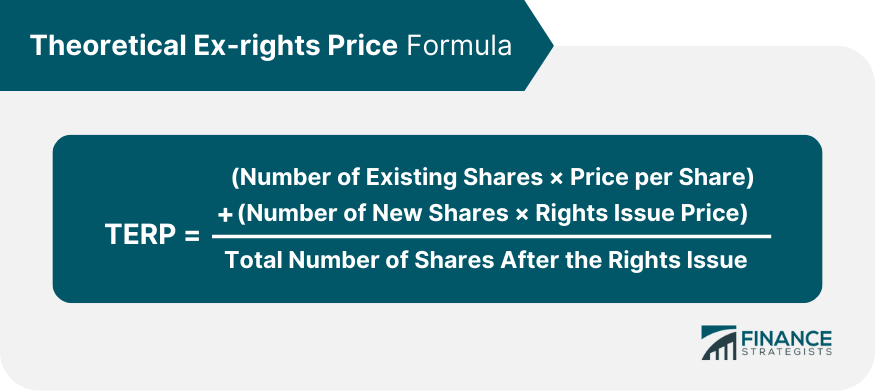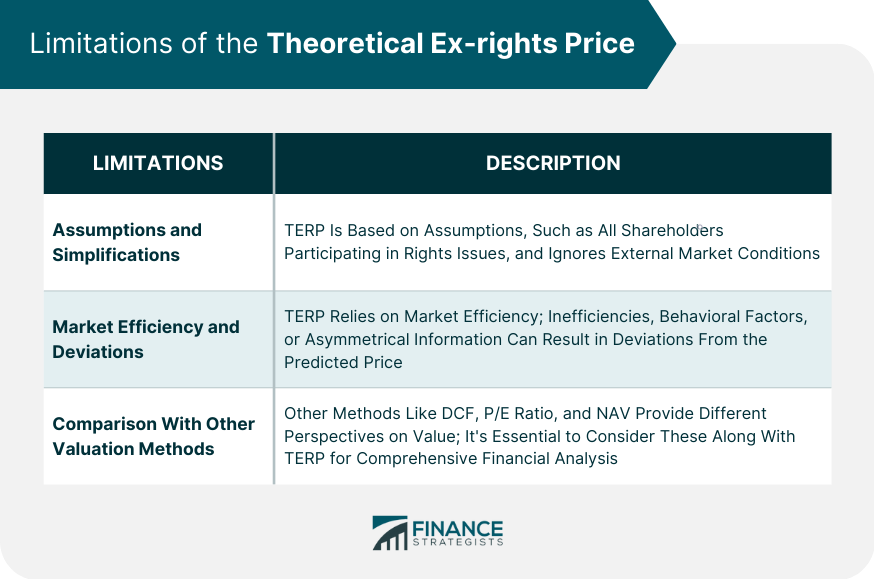The Theoretical Ex-rights Price (TERP) is a financial concept used in corporate finance to calculate the expected trading price of a share following a rights issue. It provides a theoretical prediction of the post-issue share price based on the prices of existing shares and the new rights shares. TERP helps investors and corporations assess the potential financial impact of rights offerings and make informed decisions regarding participation in such offerings. By comparing the TERP with the current market price, investors can evaluate the attractiveness of a rights issue. Corporations can use TERP to determine the optimal terms of their rights offerings and analyze the effects on existing shareholders. Overall, TERP is a valuable tool for understanding the implications of rights issues and facilitating efficient capital allocation. TERP plays a significant role in corporate finance for several reasons. Firstly, it offers a theoretical projection of a company's share price following a rights issue. This information is invaluable for both the company issuing the shares and the potential investors, as it provides an understanding of the likely financial outcome of the transaction. Secondly, TERP is a critical instrument in managing investor relations and market sentiment. By providing a forecast of the share price post-rights issue, it helps to prevent a negative market reaction that could potentially arise due to an unanticipated dilution of share value. Moreover, the transparency and predictability provided by TERP promote trust and confidence among investors. Lastly, TERP is significant in the valuation and pricing of new shares during a rights issue. By estimating the post-issue share price, it offers a reference point that can be used to set a fair price for the new shares, ensuring that both the corporation and the investors get a fair deal. A rights issue is a strategy that publicly traded corporations employ to raise additional capital. They do this by offering existing shareholders the opportunity to purchase more shares of the company, often at a discount to the current market price. This offer is typically proportional to the number of shares that an investor already owns. The TERP is calculated using the following formula: This formula illustrates the weighted average of the current market price and the rights issue price. Several factors can influence the calculation of TERP. These include the current market price of the shares, the rights issue price, the number of existing shares, and the number of new shares being offered. Changes in any of these factors will directly impact the calculated TERP. TERP plays a vital role in determining the fair value of rights shares. By projecting the share price post-rights issue, it allows the company and investors to establish a fair price for the new shares. TERP helps to assess the potential impact of a rights issue on existing shareholders. It provides a forecast of the post-issue share price, offering insight into the likely dilution of share value. This helps shareholders to make informed decisions about whether to participate in the rights issue. By projecting the post-issue share price, TERP allows potential investors to make informed decisions about participating in rights offerings. It offers an indication of the potential return on investment, aiding investors in weighing up the potential benefits and risks. While TERP provides a useful theoretical model, it is based on several simplifications and assumptions. It assumes that all shareholders will take up their rights, which may not be the case in reality. Furthermore, TERP does not account for external market conditions, which could have a significant impact on the actual post-issue share price. Another criticism of TERP is that it assumes market efficiency, which is not always the case. Market inefficiencies, irrational investor behavior, or information asymmetry can all cause deviations from the theoretically predicted share price. There are various other valuation methods used in corporate finance, such as discounted cash flow (DCF), price-to-earnings (P/E) ratio, and net asset value (NAV). These methods have their strengths and weaknesses and can offer different perspectives on a company's value compared to TERP. Therefore, it's important for investors and companies to consider multiple valuation methods when making financial decisions. Software tools and spreadsheets, like Microsoft Excel, are commonly used for calculating TERP. These tools provide a flexible platform for performing the necessary calculations and allow for easy adjustment of variables. There are also several online calculators and websites dedicated to TERP calculation. These platforms often simplify the process, making it more accessible for individuals without a strong financial background. For those seeking a deeper understanding of TERP and its applications, professional guidance from financial advisors and academic resources can be invaluable. Research papers, financial textbooks, and online courses provide extensive information on the topic. The Theoretical Ex-Rights Price (TERP) is a financial concept used in corporate finance to calculate the expected trading price of a share following a rights issue. It provides a theoretical prediction of the post-issue share price based on the prices of existing shares and the new rights shares. TERP helps investors and corporations assess the financial impact of rights offerings and make informed decisions. It is calculated using a formula that takes into account the number of existing shares, the price per share, the number of new shares, and the rights issue price. TERP is important in determining the fair value of rights shares, assessing the impact on existing shareholders, and aiding investment decisions. However, TERP has limitations and simplifications, such as assuming all shareholders will participate and not considering external market conditions. It is also important to consider other valuation methods alongside TERP for comprehensive financial analysis. Tools like financial modeling software, online calculators, and professional guidance are available for TERP calculation and further understanding.Definition of the Theoretical Ex-rights Price (TERP)
Purpose and Significance of TERP in Corporate Finance
Calculation of the Theoretical Ex-rights Price
Understanding the Concept of Rights Issues
Calculation Formula for the Theoretical Ex-rights Price

Factors Influencing the Theoretical Ex-Rights Price Calculation
Importance of the Theoretical Ex-rights Price in Rights Issues
Determining the Fair Value of Rights Shares
Assessing the Impact of Rights Issues on Existing Shareholders
Making Informed Investment Decisions During Rights Offerings
Limitations and Criticisms of the Theoretical Ex-rights Price
Assumptions and Simplifications in TERP Calculation
Market Efficiency and Deviations From TERP
Other Valuation Methods and Their Comparison to TERP

Resources and Tools for TERP Calculation
Financial Modeling Software and Spreadsheets
Online Calculators and TERP Calculation Websites
Professional Guidance and Academic Resources on TERP
Conclusion
Theoretical Ex-rights Price (TERP) FAQs
The Theoretical Ex-Rights Price (TERP) is a calculated price that represents the expected price of a share following a rights issue. It's a theoretical average of the current market price and the discounted rights issue price, taking into consideration the number of existing shares and new shares.
The calculation of the Theoretical Ex-Rights Price (TERP) involves a specific formula: TERP = [(Number of existing shares * Price per share) + (Number of new shares * Rights issue price)] / Total number of shares after the rights issue. This formula gives a weighted average price, theoretically estimating the share price after the rights issue.
The Theoretical Ex-Rights Price (TERP) is significant in corporate finance because it provides a theoretical prediction of the post-issue share price, aiding in the valuation and pricing of new shares during a rights issue. It helps manage investor relations and market sentiment, making it a valuable tool in decision-making processes during rights offerings.
While useful, the Theoretical Ex-Rights Price (TERP) has some limitations. It's based on the assumption that all shareholders will take up their rights, which isn't always the case. Furthermore, TERP doesn't consider external market conditions and assumes market efficiency, both of which can significantly impact the actual share price.
There are several resources and tools available for Theoretical Ex-Rights Price (TERP) calculation. You can use financial modeling software and spreadsheets like Microsoft Excel, online calculators, and specific websites dedicated to TERP calculation. Moreover, professional guidance from financial advisors and academic resources can provide in-depth understanding and knowledge about TERP.
True Tamplin is a published author, public speaker, CEO of UpDigital, and founder of Finance Strategists.
True is a Certified Educator in Personal Finance (CEPF®), author of The Handy Financial Ratios Guide, a member of the Society for Advancing Business Editing and Writing, contributes to his financial education site, Finance Strategists, and has spoken to various financial communities such as the CFA Institute, as well as university students like his Alma mater, Biola University, where he received a bachelor of science in business and data analytics.
To learn more about True, visit his personal website or view his author profiles on Amazon, Nasdaq and Forbes.











